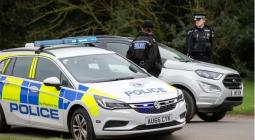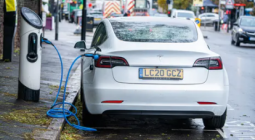Streets ahead? What I’ve learned from my year with an electric car

Record sales and now news of a battery that lasts hundreds of miles. It’s getting better, but going green was tough, admits a reluctant pioneer
This time last year my partner John and I celebrated purchasing an electric car by driving through London to see the Christmas lights without having to pay congestion or Ulez – ultra-low emission zone – charges. I gleefully tweeted that Regent Street, deserted in lockdown, seemed a London from a different era: empty roads and glittering shop windows.
This was my first moment of enjoyment of the electric vehicle (EV), whose purchase had been the source of considerable domestic tension. An eternal optimist, John was convinced we should dispense with a diesel car. The arrival of a grandchild, living at the opposite diagonal corner of London, tipped the balance. It would cut 30 minutes off a hellish journey.
I mainly saw negatives. I liked my nippy BMW and had range anxiety. How far could we go before the battery failed? Would we be able to do long drives? Were our meandering journeys through France finished for good? “Of course we’ll go,” John said. ‘The French are way ahead of us when it comes to electric.”
Not in the Tesla price bracket, we settled on a Renault Zoe. Of the cheaper cars, it had the longest range: about 240 miles on a full charge, weather and driving conditions dependent. But all EVs are expensive – £31,000 for this small and far-from-luxury car. We opted to lease, paying a small amount of cash and then monthly payments.
From the outset the whole experience was distinctly lacking in frills; a couple of young petrolheads waved us goodbye with minimal induction to the car and no information about the charging infrastructure, except to “use the Zap[-Map] app to find a charge point”.
One piece of info that would have been handy for our survival was that EVs have incredible acceleration. We had been in eco-mode since purchasing the car, when, on the first trip outside London, we found ourselves labouring up a hill, accelerator flat to the floor and still only hitting 55mph. John reached over and switched off eco-mode “to see what happens”. Pinned against the seats by the sheer force, we took off like a rocket.
We were on our own trying to figure out the mysteries of the country’s charging network. BP rang, offering us a charging point outside our house. This domestic charging is cheapest but, living in a London terrace, we were ineligible. Instead we became aficionados of charging lamp-posts, relatively common in our area. But, as often with EVs, there is a catch. Wandsworth borough council does not reserve the parking spaces for EVs, so “ordinary” cars park there, displacing EVs, which are forced to hunt around for one of the faster, more expensive chargers.
There are numerous providers and not very numerous chargers. Each provider requires you to download its app and subscribe. They all work differently and prices vary. Many chargers are out of order.
Problems are most visible on longer journeys. When lockdown was relaxed in May we booked to stay at Derek Gow’s rewilding project in Devon. We planned to stop where there were “clusters” of chargers but still got caught out, idling away an hour in a glum corner of Amesbury in Wiltshire, only to discover the charger had stopped working after 10 minutes.
After that, it was a hunt for other chargers in obscure garden centres, supermarkets and garages. Some worked, some did not, but we began to meet the community of electric adventurers, passing time waiting for chargers by comparing apps, prices and “worst EV journeys”.
Most places are willing to help out with charging. They were happy to sling a wire at Gow’s and on the way back, the Bull hotel in Bridport, Dorset – booked last minute – didn’t turn a hair, reserving us a place by an external charging point. “We’d better get used to this,” they said. But plugging into unprepared domestic supplies is not always successful. In June we managed to blow the electrics of our friends’ home in Kent. By July I noticed my range anxiety was fading. I didn’t think twice about a trip to North Yorkshire. I no longer watched the battery gauge. If the car said it would do another 106 miles, it meant it. Stops could be planned confidently. A new mentality was creeping in: “get as far as you can” was replaced by scheduling in longer stops and delays.
But “laid-back” only works up to a point. There were still anxious moments – chargers not working, less-than-helpful helplines and ever more provider registrations. The new anxiety was charge anxiety – not that the car cannot do it, but that chargers will not be available.
By August it was decision time for France. John was still pushing for the 700-mile journey in this car. I was just as set against it: I could not recall seeing chargers around and my French source said our destination village had a charger that was invariably hors service.
I got my way and was also proved right. Once there and able to look around, it was clear France was not electric car nirvana after all. So the French EV adventure still awaits. By autumn the car was a useful, boring thing rather than a source of anxiety. We could drive to and fro to Kent on one charge, smugly travel across central London, laugh at the fuel shortages and reduce charge anxiety by sticking to reliable chargers.
But I noticed gender division was setting in. John had most of the apps on his phone and did more of the technical side, especially midnight trips to find a lamp-post. This is typical, judging from encounters with the informal club of early adopters, mainly male, around the charging points.
So, I no longer have diesel particles on my conscience and changes in driving habits augur well for the environment. Conscious of conserving energy, you drive at lower speeds, while travel by train for longer journeys becomes more appealing. But the unnecessarily complicated charger network leaves everything to be desired. There is no universal charge card for all suppliers and far too few chargers overall. This will be a huge problem when EV numbers increase. Lack of government regulation is also ridiculous: as things stand, multiple suppliers face no comeback if they fail to keep chargers working.
I cannot say the electric car has widened my horizons, but it has made me plan more carefully for reaching them.
cover photo: Ros Coward and her partner John top up their Renault Zoe at a charging point in Whitstable, Kent. Photograph: Andy Hall/the Observer





